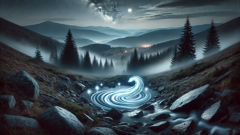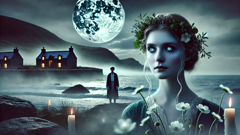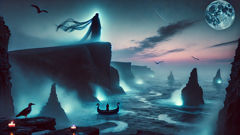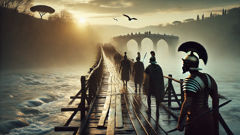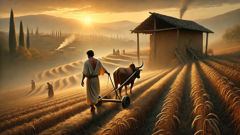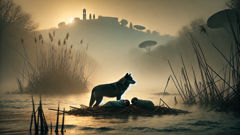Introduction
On the high ridges of the Ukrainian Carpathians, where mist gathers in the hollows like memory and the wind walks slow and familiar, there is a place shepherds call the White Hollow. They whisper of a creature older than any count of winters, a white snake whose scales catch moonlight like a line of constellations and whose tongue tastes the truth of a person’s intentions. People who have seen her speak in low voices; those who have touched a scale say the touch is like a cold, clear bell struck in the chest. The story begins with an ordinary spring—when thawed rivers ran brown with mountain soil and primroses first dared to lift their faces—and with a woman named Oksana, who kept a small flock and a stubborn faith, a scholar named Mykhailo who chased manuscripts and questions to the edges of maps, and an old shepherd simply known as Ivan, who knew the names of every ridge. Each of them, in different ways, was about to find the hollow’s resident and face the slow, exact tests she set for any visitor. The snake was not a monster and not a treasure either; she was a mirror, a keeper of balance between land and heart. Those who sought boons came for many reasons: hunger, longing, restoration, or out of sheer curiosity. But the hollow’s rule was not to take; it answered only those who could give back in the right measure. The tale gathers light and shadow in equal measure—of songs sung at hearths and cold nights beneath pines, of bargains earned through kindness rather than cunning, and of a wisdom that moved like a slow river beneath stones. If you listen closely, you can still hear the clack of distant hooves and the ripple of a voice saying: “She gives, but she first asks.”
The First Winter: Oksana’s Choice and the Snake’s Test
The first to seek the snake was Oksana. She was neither rich nor renowned; she tended a handful of sheep and kept a small jar of honey for winter’s hush. Yet what she had in abundance was stubbornness and an old memory: when she was a child her mother had once spoken of a white snake that could mend a broken well, restore a dried spring, or teach a human to hear the language of rivers. For a few years the spring near Oksana’s cottage had slowed to a trickle, and the garden that had fed them now begged for water. The other villagers muttered about drought and cursed weather, but Oksana remembered her mother’s hand on a cooling forehead and the recipe for hope: to walk to the White Hollow when the thistle was in bloom and to ask the creature with an honest heart.
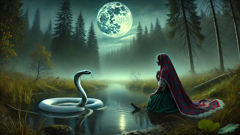
She set out before dawn with a small bundle: crusty bread, a round of cheese, a carved wooden cross her grandmother had made, and a woven kerchief stained with the colors of her homeland. The mountain trail rose like a thought and disappeared into cloud. Old stones leaned like sleepers and the air tasted of iron and pine. Oksana walked slowly to honor the journey: she greeted each nettle and frog by name, sang to the ravens, and left small offerings of grain by stony cairns, following the sort of reverence found in the oldest of folkways. Near noon, when the sun found a place to lick at the ridge, she reached the hollow. The pool at its center was rimed with water plants that trembled as if under a hush. For a long time nothing moved. Then the surface broke and the white snake rose.
She was larger than Oksana had imagined, as thick around as the shepherd’s staff, yet graceful with a motion that suggested the slow, inevitable flow of seasons. Her eyes held no malice. The creature did not speak in words, but Oksana felt an awareness flow into her head like warm water into a dry cup. The snake’s first test was not to ask for a task or to render a riddle; she asked for witness. She touched her tongue to Oksana’s palm and, in a voice like wind through reeds, asked: "Who will remember, if you take what I give? Who will you answer to when the well sings again?"
Oksana thought of her mother and of the other women near the hearth who had taught her the names for herbs and prayers. She thought of the children who would taste the first new potatoes. She thought of songs that needed to be sung for future harvests. She realized the test was about stewardship. When she answered, she did not plead for an immediate miracle; she promised only that she would not waste the gift. She offered to share the water and to gather the villagers to learn how to conserve it. The snake’s tongue touched the worn cross and left a faint shimmer. The pooled water shivered and then began a steady flow at the hollow’s edge. Oksana filled her clay jug and did not take more than she needed. On the return the path seemed kinder: distant families came to the new spring and felt a relief they had not known for a long while. She kept her promise and taught others, and for three seasons the spring never fully died.
But the snake’s tests are careful; they are not finished at first favor. Months later a trader from the lowlands arrived with offers to buy the spring at a price dearer than reason. Greed is a slow thing that tastes like winter; it asks, politely at first, for compromise. Oksana refused; she would not sell it. Instead she proposed a council with elders, women, and boys so that the spring would belong to the community and be tended by many hands. The trader scoffed and left. The story spread of how one woman kept her pledge and of a white snake who chose whom to answer. It taught the villagers a way of honoring the land that outlived the memory of the trader’s wretched purse.
People spoke then of the snake’s blessing as if it were a miracle, but those who had watched with Oksana understood it differently: the hollow’s gift was a kind of careful partnership. The creature neither punished nor rewarded out of whim; she measured the heart’s capacity to hold responsibility. And those measurements were exacting. Another winter, when wolves hunted thin from hunger and the moon hung like an old coin, a man who had watched Oksana from afar decided to present himself as worthy. His name was Petro, a man with eyes that could not quite hide a sharp hunger for betterment. He brought gold—stolen, it turned out—and demanded that the snake lift his misfortunes. The serpent saw through the false offering and refused. Petro’s greed hardened his hands and broke his luck. He learned only after losing nearly everything that the gifts of the hollow were not for sale.
Long after Oksana’s hair grew white at the temples she would tell the children that the snake’s first lesson had been simplicity: give thanks for what serves the many, and you will be entrusted with the many’s care. She would also remind them that sometimes an answered prayer is not a sweeping miracle but a small change that preserves a way of life. In the flicker of her hearth lamp, the image of the snake shimmered like a promise: luminous, patient, and exacting, she rewarded humility and readiness, and she sent back those who sought to bend nature to a single greedy will.
Those who came later would learn that the hollow responded to a balance between need and responsibility. Oksana’s name passed into the drone of songs, and when the primroses bloomed, mothers would whisper her story to their children as both caution and comfort. The hollow stayed—a place where the mountain kept its counsel—and the white snake, patient even among the shifting seasons, continued to measure hearts.
Mykhailo and Ivan: Questions, Bargains, and the Language of Stones
After news of the White Hollow spread beyond the nearest villages, a scholar named Mykhailo came from the lowlands. He traveled with leather-bound books and a satchel full of questions. Mykhailo’s mind hunted for knowledge like hounds chasing scent; he believed that if a thing could be known it could be named, catalogued, and explained. To him, the white snake represented a last page in a folio of uncharted knowledge. He wanted to learn how the creature, if indeed her existence was more than rumor, fit into the wider cosmology of spirits and natural law.
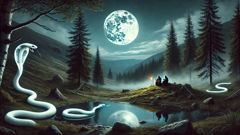
He arrived in a rain of earnest argument and midnight notes, his ink blotted by tears of impatience. He read aloud to the mountain air from scraps of travelogues and from older tomes that mentioned serpents of light in other lands. The elders listened and smiled at his certainty, for certainty is a fragile thing on the mountain, easily blown away by weather. Mykhailo climbed to the hollow with a mind waiting to be fed. The white snake watched him approach, and rather than test his heart directly, she gave him a question that sounded like a stone sinking in a deep well: "What will you return when you have learned of me?"
Mykhailo had expected a puzzle or a vision of old knowledge; instead he found himself unmoored by the necessity of reciprocity. Knowledge, the snake implied, is not a unilateral treasure. If he took an explanation from the hollow, could he return it intact to the people who had guarded it with offerings and silence? Could he honor the terms of its keeping? Mykhailo answered as scholars often do: with a promise to write, to translate, and to teach. The snake accepted, but not without condition: he must live with the shepherds and learn what the mountains had to teach him about rhythm and restraint for one full season.
Months under Ivan’s care taught Mykhailo what the books had not. Ivan spoke rarely, but his words carried the precise weight of one who had counted seasons by tramlines left in snow. He taught Mykhailo how to tie knots for rope, how to read the sky in the curl of smoke, and how to listen to the sound of a stream as it negotiated stones. Mykhailo learned a humility he had not known he lacked—the kind that comes from seeing one’s certainty softened by the slow insistence of old practice. When he returned to the hollow, the white snake did not give him a single secret but a pattern: the names of a dozen springs, the taste of certain herbs, and a lesson about the limits of translation. Some truths, she said, live less in language than in the way a community uses them. Mykhailo wrote many manuscripts afterward that blended scholarship with the manners of shepherds; his work preserved more than facts. It preserved a way of listening.
Meanwhile, Ivan had his own history with the snake. As a young man he had once been a fierce hunter, same as many were in his day, but a season of want and a wound had softened something in him. He had come upon the snake after a storm had taken his favorite flock; alone and cold, he had offered the last bread from his pack and the memory of a child’s lullaby. The snake listened, and rather than give him riches, she taught him how to track moss that favored moisture, how to find hidden channels where the soil remembered water. The lesson was practical and generous and asked of him only that he cease to kill beyond need. Ivan kept that vow, and in time his flocks prospered not because he had outsmarted the mountain but because he had learned to steward it.
The hollow’s pattern is stubbornly moral without sermonizing. For some, its gift is a new well; for others, a warning that echoes in midnight dreams. Mykhailo returned to town to publish, to argue, to propose classifications that earned him both admiration and quiet dissent. His treatises carried a new humility: each time he referenced the hollow, he credited a council of nameless women and shepherds. This small act of accounting kept a balance that the snake required. When translators came seeking to profit by selling the hollow’s mysteries abroad, Mykhailo refused to commodify what he had learned. He understood that some knowledge, when stripped of context and shared as spectacle, loses its power to hold people to their promises.
Ivan and Mykhailo taught different lessons to the people who visited the hollow afterward. Ivan taught patience: living with the mountain is living with slow truths. Mykhailo taught restraint: a borrowed secret must always be returned in a way that repairs the community’s seams. Together, they formed a kind of living library—one of hands and land rather than ink and feathers—and the hollow’s story grew more complex. People came seeking cures for grief, for lost kin, for fortunes; some were returned with pockets full of nothing, some with cures that meant more duty. In each case the white snake measured the gift to fit the one who asked. She required not just desire, but the promise of stewardship. A widow who asked to hear her husband’s voice one last time received it not as betrayal of nature but as a whisper that taught her how to harvest and mend, so she could keep the family that remained. A youth who asked for strength was given instead the knowledge of how to carry weight together with neighbors so no one should heave it alone.
Rumors sometimes spun into fear. Travelers told tales of men turned to stone, of jealous spites and dark bargains. But those who lived near the hollow spoke in steadier tones: nothing glamorous, nothing cruel beyond measure. If there was a moral harshness in the snake, it lay only in the truth that some requests unsettle a place’s balance. Ask from greed, and what you receive will suit your greed’s fate; ask from need, and the hollow will devise a way to mend the need without undoing the whole. The white snake’s wisdom was less a law than an ecology: a measure of how much any one life may take before the ground gives way.
Over years the hollow’s lore grew richer—songs took its contour, and children were taught in plays that reenacted the snake’s clever tests. Festivals in spring and harvesttime gave thanks with dances that curved like the serpent’s spine. People began to understand that the legend’s heart was not the snake’s power to grant but the mountain’s patience to choose. The creature kept watch as seasons braided hair with silver, and she continued to seek those whose hearts were tuned to the small economies of giving. When she moved through the hollow, the trees bowed in a manner that might be superstition or might simply be the way light and life yield to age. In either case, the lesson endured: wisdom visits those who listen, and when it leaves, it asks you to pass on the listening to others.
Conclusion
Years went by and the White Hollow remained a place of stories braided into the daily life of the Carpathians. The white snake’s lessons—of measured asking, of returning what you take, and of the steady stewardship of community—wove themselves into songs, seasonal rituals, and the very way people tended land and kin. Travelers from distant towns sometimes called it superstition; those who lived under the mountain’s skirts knew it as a pact between humans and the older world. Generations learned that the snake’s boons were not a fast fix but a covenant: to receive was to promise to repair and to give back. In a time when so many voices pressed for instant gain, the legend of the White Snake of the Carpathians endured as a quiet counsel—gentle, precise, and unforgiving in its requirement for honesty. The hollow still breathes in mist and memory, and the mountain keeps its own counsel. If you stand there long enough, listening to the small sounds that the world gives off—water finding stone, the distant call of a bell—you may hear, faint as a distant bell, the whisper of the snake asking a straightforward question: Who will remember? The answer, if given rightly, opens a life that is both modest and rich, a life tethered to land and to others. Thus the Carpathians hold their secret: not as a treasure to be taken in haste, but as a trust to be tended across seasons. In that tending lies the truest boon.

